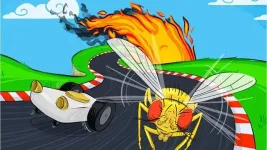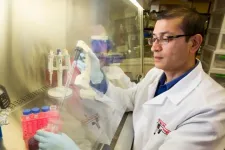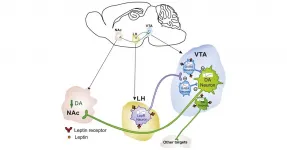(Press-News.org) With over 70% of respondents to a AAA annual survey on autonomous driving reporting they would fear being in a fully self-driving car, makers like Tesla may be back to the drawing board before rolling out fully autonomous self-driving systems. But new research from Northwestern University shows us we may be better off putting fruit flies behind the wheel instead of robots.
Drosophila have been subjects of science as long as humans have been running experiments in labs. But given their size, it's easy to wonder what can be learned by observing them. Research published today in the journal Nature Communications demonstrates that fruit flies use decision-making, learning and memory to perform simple functions like escaping heat. And researchers are using this understanding to challenge the way we think about self-driving cars.
"The discovery that flexible decision-making, learning and memory are used by flies during such a simple navigational task is both novel and surprising," said Marco Gallio, the corresponding author on the study. "It may make us rethink what we need to do to program safe and flexible self-driving vehicles."
According to Gallio, an associate professor of neurobiology in the Weinberg College of Arts and Sciences, the questions behind this study are similar to those vexing engineers building cars that move on their own. How does a fruit fly (or a car) cope with novelty? How can we build a car that is flexibly able to adapt to new conditions?
This discovery reveals brain functions in the household pest that are typically associated with more complex brains like those of mice and humans.
"Animal behavior, especially that of insects, is often considered largely fixed and hard-wired -- like machines," Gallio said. "Most people have a hard time imagining that animals as different from us as a fruit fly may possess complex brain functions, such as the ability to learn, remember or make decisions."
To study how fruit flies tend to escape heat, the Gallio lab built a tiny plastic chamber with four floor tiles whose temperatures could be independently controlled and confined flies inside. They then used high-resolution video recordings to map how a fly reacted when it encountered a boundary between a warm tile and a cool tile. They found flies were remarkably good at treating heat boundaries as invisible barriers to avoid pain or harm.
Using real measurements, the team created a 3D model to estimate the exact temperature of each part of the fly's tiny body throughout the experiment. During other trials, they opened a window in the fly's head and recorded brain activity in neurons that process external temperature signals.
Miguel Simões, a postdoctoral fellow in the Gallio lab and co-first author of the study, said flies are able to determine with remarkable accuracy if the best path to thermal safety is to the left or right. Mapping the direction of escape, Simões said flies "nearly always" escape left when they approach from the right, "like a tennis ball bouncing off a wall."
"When flies encounter heat, they have to make a rapid decision," Simões said. "Is it safe to continue, or should it turn back? This decision is highly dependent on how dangerous the temperature is on the other side."
Observing the simple response reminded the scientists of one of the classic concepts in early robotics.
"In his famous book, the cyberneticist Valentino Braitenberg imagined simple models made of sensors and motors that could come close to reproducing animal behavior," said Josh Levy, an applied math graduate student and a member of the labs of Gallio and applied math professor William Kath. "The vehicles are a combination of simple wires, but the resulting behavior appears complex and even intelligent."
Braitenberg argued that much of animal behavior could be explained by the same principles. But does that mean fly behavior is as predictable as that of one of Braitenberg's imagined robots?
The Northwestern team built a vehicle using a computer simulation of fly behavior with the same wiring and algorithm as a Braitenberg vehicle to see how closely they could replicate animal behavior. After running model race simulations, the team ran a natural selection process of sorts, choosing the cars that did best and mutating them slightly before recombining them with other high-performing vehicles. Levy ran 500 generations of evolution in the powerful NU computing cluster, building cars they ultimately hoped would do as well as flies at escaping the virtual heat.
This simulation demonstrated that "hard-wired" vehicles eventually evolved to perform nearly as well as flies. But while real flies continued to improve performance over time and learn to adopt better strategies to become more efficient, the vehicles remain "dumb" and inflexible. The researchers also discovered that even as flies performed the simple task of escaping the heat, fly behavior remains somewhat unpredictable, leaving space for individual decisions. Finally, the scientists observed that while flies missing an antenna adapt and figure out new strategies to escape heat, vehicles "damaged" in the same way are unable to cope with the new situation and turn in the direction of the missing part, eventually getting trapped in a spin like a dog chasing its tail.
Gallio said the idea that simple navigation contains such complexity provides fodder for future work in this area.
INFORMATION:
Work in the Gallio lab is supported by the NIH (Award No. R01NS086859 and R21EY031849), a Pew Scholars Program in the Biomedical Sciences and a McKnight Technological Innovation in Neuroscience Awards.
The paper is titled "Robustness and plasticity in Drosophila heat avoidance." In addition to Gallio, Simões, Kath and Levy, authors on the paper include Emanuela Zaharieva, Leah Vinson, Peixiong Zhao, Michael Alpert and Alessia Para.
LAWRENCE -- An international trade law expert at the University of Kansas argues in a pair of new articles that human rights and trade are now inextricably linked, as evidenced by U.S. and international reactions to actions in China, and asserts that approach is an appropriate use of trade.
Raj BhalaAfter the United States, then Canada and the Netherlands, declared the Chinese Communist Party's actions against Uyghur Muslims as genocide, the nations followed with various trade sanctions. Likewise, countries have adopted trade measures in response to China's violation of its one-country, two-systems agreement with Hong Kong. ...
Researchers at the University of Konstanz and Max Planck Institute for Animal Behavior in Germany have found that birds are able to change their culture to become more efficient. Populations of great tits were able to switch from one behavior to a better alternative when their group members were slowly replaced with new birds. Published today as open access in the journal Current Biology, this research reveals immigration as a powerful driver of cultural change in animal groups that could help them to adapt to rapidly changing environments.
In animals, "culture" is considered to be any behavior that is learned from others, shared by members of the ...
Ann Arbor, April 6, 2021 - New data from the Centers for Disease Control and Prevention (CDC) show that one in four adults with HIV in the United States has experienced intimate partner violence (IPV), which disproportionately affects women and LGBT populations. Further, people with HIV who experienced IPV in the past 12 months were more likely to engage in behaviors associated with elevated HIV transmission risk, were less likely to be engaged in routine HIV care and more likely to seek emergency care services and have poor HIV clinical outcomes. The findings are reported in the American Journal of Preventive Medicine, published by Elsevier.
Lead Investigator Ansley B. Lemons-Lyn, MPH, and colleagues from the CDC's National Center for HIV/AIDS, Viral Hepatitis, ...
At a cost of $38 billion a year, an estimated 5.3 million people are living with a permanent disability related to traumatic brain injury in the United States today, according to the Centers for Disease Control and Prevention. The physical, mental and financial toll of a TBI can be enormous, but new research from the University of Georgia provides promise.
In a new study, researchers at UGA's Regenerative Biosciences Center have demonstrated the long-term benefits of a hydrogel, which they call "brain glue," for the treatment of traumatic brain injury. The new study provides evidence that not only does the gel protect against loss of brain tissue after ...
Bethesda, MD (April 6, 2021) -- Obesity is a global pandemic, affecting about 40% of adults in the United States. There is an enormous unmet need for an effective weight-loss solution. After a detailed review of available literature, the American Gastroenterological Association (AGA) has released new clinical guidelines recommending the use of intragastric balloons (IGB) for patients with obesity who have not been able to lose weight with traditional weight-loss strategies. This treatment is most successful with accompanying therapy, such as lifestyle modifications and pharmacological agents, ...
Researchers have uncovered pathways involved in the body's response to glucocorticoid treatments and identified a novel biomarker that could be used to monitor how these drugs work in patients, according to a clinical study published today in eLife.
A more reliable indicator of an individual's response to glucocorticoid drugs could be used to develop a clinically applicable test that could help tailor treatments and potentially minimise side-effects.
Glucocorticoids, such as cortisol, are a type of hormone with key roles in the body's response to stress. Glucocorticoid ...
Researchers from Skoltech and their collaborators have designed, synthesized and evaluated new compounds that can serve as catholytes and anolytes for organic redox flow batteries, bringing this promising technology closer to large-scale implementation. The two papers were published in the END ...
A new U.S. Geological Survey study provides an updated, statewide estimate of high levels of naturally occurring arsenic and uranium in private well water across Connecticut. This research builds on a USGS report published in 2017, with the new study including additional groundwater samples and focusing on previously underrepresented areas.
The research, undertaken in cooperation with the Connecticut Department of Public Health, projects that approximately 3.9% of private wells across Connecticut contain water with arsenic at concentrations higher than the U.S. Environmental Protection Agency's maximum contaminant level for ...
Sea urchins receive a lot of attention in California. Red urchins support a thriving fishery, while their purple cousins are often blamed for mowing down kelp forests to create urchin barrens. Yet for all the notice we pay them, we know surprisingly little about the microbiomes that support these spiny species.
Researchers at UC Santa Barbara led by geneticist Paige Miller sought to uncover the diversity within the guts of these important kelp forest inhabitants. Their results reveal significant differences between the microbiota of the two species, as well as between individuals living ...
Philadelphia, April 6, 2021 - Since the discovery of leptin in the 1990s, researchers have wondered, how does leptin, a hormone made by body fat, suppress appetite? Despite tremendous gains in the intervening three decades, many questions still remain. Now, a new study in mice describes novel neurocircuitry between midbrain structures that control feeding behaviors that are under modulatory control by leptin. The study appears in Biological Psychiatry, published by Elsevier.
John Krystal, MD, Editor of Biological Psychiatry, said of the findings, "Omrani and colleagues shed light on how, in non-obese animals, leptin puts the brakes on overeating."
Leptin acts as a critical link between the body and the brain, providing information about metabolic ...



